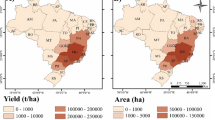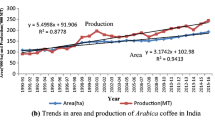Abstract
Coffee is the most consumed beverage and one of the most valuable commodities worldwide. The crop is very sensitive to meteorological elements, mainly at the microclimatic scale, such as solar radiation, air temperature, and precipitation. El Niño and La Niña are atmospheric phenomena characterized by temperature anomalies in tropical areas of the Pacific Ocean, and changing wind and precipitation patterns in tropical and mid-latitude regions. For these reasons, the objective of this study was to evaluate the influence of El Niño and La Niña on Coffea arabica and canephora yields in the states and localities of the main Brazilian coffee-producing regions. We considered the states of Minas Gerais, São Paulo, Paraná, Bahia, Espírito Santo, and Rondônia. The yield data were obtained from 79 localities for the period 2002–2017 from the Brazilian Institute of Geography. Daily mean air temperature and precipitation were obtained from the NASA-POWER platform and the quarterly registry of the value of the ONI index was obtained from the National Oceanic and Atmospheric Administration. El Niño tended to decrease precipitation, and increase temperature and water deficits for all Brazilian coffee regions. Neutral and La Niña years were climatically similar. Climatic elements tended to be less variable and favor high coffee yields during El Niño years at national, regional, and local scales. The yield increase occurred because the hottest days of EN happen in the first quarter of the phenological cycle, when the crop is normally in the vegetative phase, favoring the generation of new branches. The highest historical yields were generally correlated with the occurrence of El Niño.








Similar content being viewed by others
References
Adams RM, Houston LL, McCarl BA, Mario Tiscareño LM, Matus GJ, Weiher RF (2003) The benefits to Mexican agriculture of an El Niño-Southern Oscillation (ENSO) early warning system. Agricultural and Forest Meteorology 115:183–194
Alves MB, Souza EB, Repelli CA, Vitorino MI, Ferreira NS (1997) Episódios de La Niña na bacia do oceano pacífico e equatorial e a distribuição sazonal e intra-sazonal das chuvas no setor norte do nordeste brasileiro. Revista Brasileira de Meteorologia 12(1):63–76
Aparecido LEO, Rolim GS (2018) Forecasting of the annual yield of Arabic coffee using water deficiency. Pesq Agrop Brasileira 53(12):1299–1310
Aparecido LEO, Rolim GS, Souza PS (2014) Flowering and harvest ing periods of macadamia-walnut for areas of the southeastern coffee region. Rev Bras Frutic 36:165–173
Avelino J, Cristancho M, Georgiou S, Imbach P, Aguilar L, Bornemann G, Läderach P, Anzueto F, Hruska AJ, Morales C (2015) The coffee rust crises in Colombia and Central America (2008–2013): Impacts, plausible causes and proposed solutions. Food Security 7(2):303–321
Bai J, Chen X, Dobermman A, Yang H, Cassman KG, Zhang F (2010) Evaluation of NASA satellite- and model-derived weather data for simulation of maize yield potential in China. Agron J 102(1):9–16
Barnston AG, Tippett MK, L'Heureux ML, Li S, DeWitt DG (2012) Skill of real-time seasonal ENSO model predictions during 2002–11: is our capability increasing? Bull Am Meteorol Soc 93(5):631–651
Bastianin A, Lanza A, Manera M (2018) Economic impacts of El Niño southern oscillation: evidence from the Colombian coffee market. Agric Econ 1:3–17
Berlato MA, Farenzena H, Fontana DC (2005) Associação entre El Niño Oscilação Sul e a produtividade do milho no Estado do Rio Grande do Sul. Pesq Agrop Brasileira 40(5):423–432
Café de Colombia (2014) Our coffee regions. Retrieved from: <http://www.cafedecolombia.com>
Camargo AP (1971) Balanço hídrico no Estado de São Paulo. 3.ed. Campinas: Instituto Agronômico. 24p. (Boletim, 116)
Camargo AP (1985) Florescimento e frutificação de café arábica nas diferentes regiões cafeeiras do Brasil. Pesq Agrop Brasileira 20(7):831–839
Camargo MBP (2010) The impact of climatic variability and climate change on arabic coffee crop in Brazil. Bragantia. 69:239–247
Camargo AP, Camargo MBP (2001) Definição e esquematização das fases fenológicas do cafeeiro arábica nas condições tropicais do Brasil. Bragantia. 60(1):65–68
Carmona LC, Berlato MA (2002) El Niño e La Niña e a produtividade do arroz irrigado no Estado do Rio Grande do Sul. Revista Brasileira de Agrometeorologia. 10(1):147–152
Chen D, Cane MA, Kaplan A, Zebiak SE, Huang D (2004) Predictability of El Niño over the past 148 years. Nature. 428(6984):733–736
Chimeli A, Souza Filho F, Holanda M, Petterini F (2008) Forecasting the impacts of climate variability: lessons from the rainfed corn market in Ceará. Brazil Environment and Development Economics 13(2):201–227
Cirino PH, Féres JG, Braga MJ, Reis E (2015) Assessing the Impacts of ENSO-related weather effects on the Brazilian Agriculture. Procedia Economics and Finance 24:146–155
Climate Prediction Center – CPC (2012) Frequently asked questions about El Niño and La Niña. Retrieved from:<https://www.cpc.ncep.noaa.gov/products/analysis_monitoring/ensostuff/ensofaq.shtml#forecasts>
Companhia Nacional de Abastecimento – CONAB (2019) Acompanhamento da safra brasileira de café. 6(1)
Craparo ACW, Van Asten PJA, Läderach P, Jassogne LTP, Grab SW (2015) Coffea arabica yields decline in Tanzania due to climate change: global implications. Agric For Meteorol 207:1–10
Cressey D (2013) Coffee rust regains foothold. Nature. 493-587
Cunha DR, Dalmargo GN, Estefanel D, Pasinato A, Moreira MB (2001) El Niño-Oscilação Sul e seus impactos sobre a cultura da cevada no Brasil. Revista Brasileira de Agrometeorologia 9(1):137–1345
Damatta FM (2004) Ecophysiological constraints on the production of shaded and unshaded coffee: a review. Field Crop Res 86:99–114
Damatta FM, Ramalho JDC (2006) Impacts of drought and temperature stress on coffee physiology and production: a review. Braz J Plant Physiol 18(1):55–81
Decasy F, Avelino J, Guyot B, Perriot JJ, Pineda C, Cilas C (2003) Qualidade de diferentes cafés hondurenhos em relação a diferentes meio ambientes. J Food Sci 68(7):2356–2361
Dineshes KP, Shivanna P, Santa Ram A (2011) Identification of RAPD (random amplified polymorphic DNA) markers for Ethiopian wild Coffea arabica L genetic resources in the tropics. Institute of Integrative Omics and Applied Biotechnology Journal 2(4):1–7
Eskes A (2005) Phenotypic expression of resistance to coffee leaf rust and its possible relationship with durability. In: Durable Resistance to Coffee Leaf Rust. Viçosa-MG. Universidade Federal de Viçosa, 305-331
Figueroa P, Jimenez OH, Lópes de LE, Anzueto F (2000) Influencia de la variedad y la altitud en las características organolepticas y físicas del café. In: Simpósio Latinoamericano De Cafeicultura, 19., 2000, San José, Costa Rica. Memoria... San José: ICAFE. 493-497
Fraser J, Fisher E, Arce A (2014) Reframing ‘crisis’ in fair trade coffee production: trajectories of agrarian change in Nicaragua. J Agrar Chang 14(1):52–73
Grimm AM, Barros VR, Doyle ME (2000) Climate Variability in Southern South America associated with El Niño and La Niña events. J Clim 13(1):35–57
Hoogenboom G (2000) Contribution of agrometeorology to the simulation of crop production and its applications. Agric For Meteorol 103(1/2):137–157
Instituto Brasileiro de Geografia e Estatística – IBGE. (2018). Sidra: Banco de Tabelas Estatísticas. Retrieved from: <https://sidra.ibge.gov.br>
International Coffee Organization – ICO (2019). Coffee trade statistics. Retrieved from: <http://www.ico.org>
Júnior RDSN, Sentelhas PC (2019) Soybean-maize off-season double crop system in Brazil as affected by El Niño Southern Oscillation phases. Agric Syst 173:254–267
Li Y, Yi F, Wang Y, Gudaj R (2019) The Value of El Niño-Southern oscillation forecasts to China’s agriculture. Sustainability. 11(15):4184
Mcphee J, Margulis SA (2005) Validation and error characterization of the GPCP-1DD precipitation product over the contiguous United States. J Hydrometeorol 6:441–459
Meireles EJL, Camargo MBP, Pezzopane JRM, Thomaziello RA, Fahl JI, Bardin L, Santos JCF, Japiassú LB, Garcia AWR, Miguel AE, Ferreira RA (2009) Fenologia do cafeeiro: condições agrometeorológicas e balanço hídrico do ano agrícola 2004-2005. Brasília: Embrapa Café; MAPA 5:130
Miao R, Khanna M, Huang H (2016) Responsiveness of crop yield and acreage to prices and climate. American Journal of Agricultural Economics 98:191–211
Moeletsi ME, Walker S (2012) Evaluation of NASA satellite and modelled temperature data for simulating maize water requirement satisfaction index in the Free State Province of South Africa. Physics and Chemistry of the Earth, Parts A/B/C 50-52:157–164
Phillips J, Cane M, Rosenzweig C (1998) ENSO, Seasonal rainfall patterns and simulated maize yield variability in Zimbabwe Agricultural and Forest Meteorology 90:39–50
Phillips J, Rajagopalan B, Cane M, Rosenzweig C (1999) The role of ENSO in determining climate and maize yield variability in the US cornbelt. International Journal of Climatology 19:877–888
Pinault JL (2016) Anticipation of ENSO: What teach us the resonantly forced baroclinic waves. Geophysical & Astrophysical Fluid Dynamics 110(6):518–528
Poveda G, Jaramillo A, Gil MM, Quiceno N, Mantilla RI (2001) Seasonally in ENSO-related precipitation, river discharges, soil moisture, and vegetation index in Colombia. Water Resour Res 37(8):2169–2178
Prela AP, Pereira AR, Caramori PH (2005) Influência dos fenômenos El Niño/La Niña na produtividade de trigo no estado do Paraná. Revista Brasileira de Agrometeorologia. 13(3):341–342
Rena AB, Maestri M (1986) Coffee Physiology. In: A.B. Rena et al. (guest eds) Cultura do cafeeiro: fatores que afetam a produtividade. Piracicaba, SP: POTAFOS. pp. 447.
Rendón EPD, Builes VHR, Quiñones AJP (2015) Variabilidad espacial y temporal de la temperatura del aire en la zona cafetera colombiana. Investigaciones Geográficas. Boletín 89
Rodrigues WN, Tomaz MA, Ferrão RG, Ferrão MAG, Fonseca AFA (2013) Crop yield bienniality in groups of genotypes of conilon coffee. Afr J Agric Res 8:4422–4426
Serrano CEB, Castrillón JJC (2002) Influência de la latitude en la calidad de la bebida de muestras del café procedente del ecotopo 206 B en Colombia. Cenicafé. 53(2):119–131
Silva CA, Teodoro REF, Melo B (2008) Produtividade e rendimento do cafeeiro submetido a lâminas de irrigação. Pesq Agrop Brasileira 43:387–394
Smith AW (1989) Introduction. In: Clarke RJ, Macrae R (eds), Coffee – Chemistry.1:1-41
Souza Júnior JA, Nechet D, Oliveira MCF, Albuquerque MF (2009) Estudo do comportamento da temperatura e precipitação nos períodos chuvosos e menos chuvosos em Belém-PA em anos de fortes eventos de El Niño e La Niña. Revista Brasileira de Climatologia 5:87–101
Stackhouse PW, Zhang T, Westberg D, Barnett AJ, Bristow T, Macpherson B, Hoell JM (2018) Power release 8.0.1 (with GIS applications) methodology (Data parameters, sources & validation). Retrieved from <https://power.larc.nasa.gov/documents/POWER_Data_v9_methodology.pdf>
Syvertsen JP, Garcia-Sanchez F (2014) Multiple abiotic stresses occurring with salinity stress in citrus. Environ Exp Bot 103:128–137
Thornthwaite CW, Mather JR (1955) The water balance. Centerton: Drexel Institute of Technology. Climatology 8(1):104
Ubilava D, Abdolrahimi M (2019) The El Niño impact on maize yields is amplified in lower income teleconnected countries. Environ Res Lett 14(5):054008
Westberg D, Soja A, Stackhouse JRPW (2010) Linking satellite-derived fire counts to satellite-derived weather data in fire prediction models to forecast extreme fires in Siberia. Geophys Res Abstr 12:2010–5597
White JF, Hoogenboom G, Stackhouse JRPW, Hoell JM (2008) Evaluation of NASA satellite- and assimilation model-derived long-term daily temperature data over the continental US. Agric For Meteorol 148:1574–1584
Author information
Authors and Affiliations
Corresponding author
Additional information
Publisher’s note
Springer Nature remains neutral with regard to jurisdictional claims in published maps and institutional affiliations.
Rights and permissions
About this article
Cite this article
Almeida Silva, K., de Souza Rolim, G., Borges Valeriano, T.T. et al. Influence of El Niño and La Niña on coffee yield in the main coffee-producing regions of Brazil. Theor Appl Climatol 139, 1019–1029 (2020). https://doi.org/10.1007/s00704-019-03039-9
Received:
Accepted:
Published:
Issue Date:
DOI: https://doi.org/10.1007/s00704-019-03039-9




